Advanced Search
Results 1461 - 1480 of 2131
LL9450U
LL9470U
LL9641U1
Up Flexible Packaging Solutions with GC New Resin to Serve Sustainability Trends!
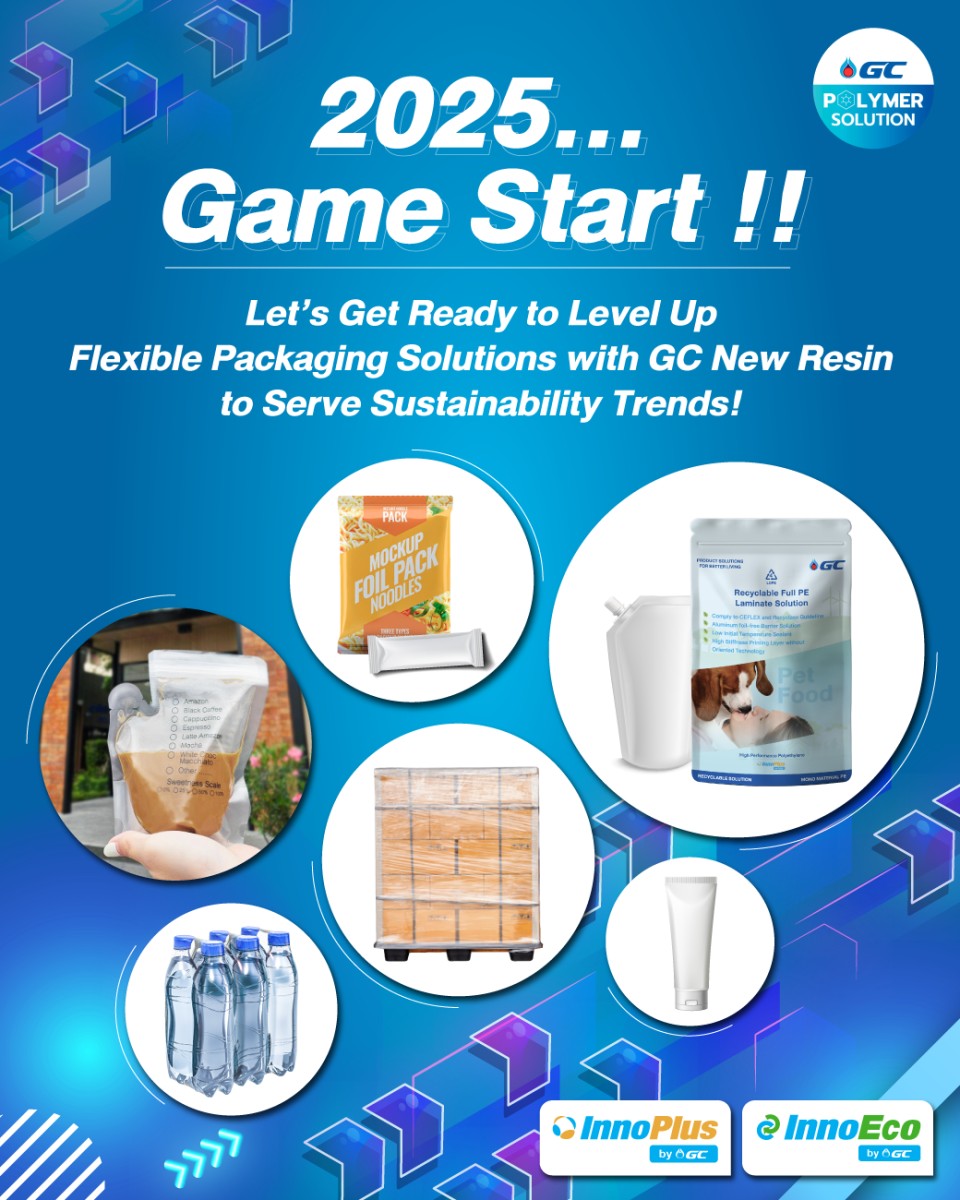
2025…Game Start!! Let’s Get Ready to Level Up Flexible Packaging Solutions with GC New Resin to Serve Sustainability Trends!
GC invites you to experience high-quality plastic resin innovations, internationally certified, manufactured using cutting-edge technology, and specifically for flexible packaging solutions that meet the needs of both businesses and consumers, paving the way for sustainable future!
GC’s plastic resins are versatile and include new grades such as PE from InnoPlus by GC and PCR from InnoEco by GC. These enable customers to customize production formulas for various types of Flexible Packaging including Lamination film, Non-lamination film, Shrink film, Stretch film, Heavy duty bag, Squeeze tube
Example of Flexible Packaging Solution serving Sustainability Trend from GC resins include:
GC is ready to meet all your packaging production needs, focusing on convenience, durability, and sustainability to create better future for all.
And this is just the beginning! GC prepares to deliver more outstanding products that not only drive your business growth but also contribute to greener world throughout the year.
ENVICCO’s T-VER certification advances its Low-CO2 goals
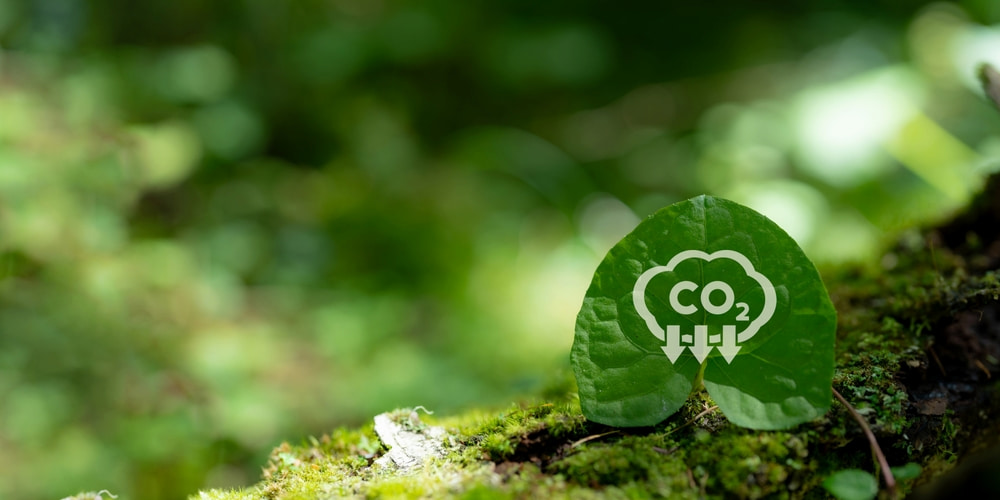
Environmental issues—especially global warming—have become a critical global challenge that demands collective action from governments, private sectors, and individuals. In response, Thailand established the T-VER program to encourage organizations and companies to voluntarily reduce greenhouse gas emissions.
ENVICCO, a leading bioplastics manufacturer in Thailand specializing in high-quality recycled plastic pellets, is the first company in the country to earn T-VER carbon credits from a waste management activity. To recover and recycle plastic from waste, the project employed voluntary greenhouse gas reduction techniques.
The T-VER Program: Encouraging Voluntary Carbon Reduction
The T-VER program—short for Thailand Voluntary Emission Reduction Program—is a national framework developed by the Thailand Greenhouse Gas Management Organization (TGO). The initiative promotes voluntary participation from all sectors in reducing the nation’s greenhouse gas emissions. Participants in the T-VER program carry out activities that reduce emissions and, in return, receive T-VER carbon credits.
Types of T-VER Projects
To qualify for the T-VER program, participants must undertake projects in one of the following categories:
Renewable Energy
Transitioning to renewable or clean energy to curb carbon dioxide emissions.
Transport
Using energy-efficient transportation systems, including electric vehicles, to cut emissions from the transport sector.
Energy Efficiency
Implementing energy-saving measures in buildings, factories, and homes to reduce energy consumption and emissions.
Factory
Manufacturing and operations that reduce greenhouse gas emissions, such as using natural refrigerants or alternatives to clinker.
Waste
Improving waste management practices to minimize methane emissions and reduce landfill areas.
Land Use
Increasing green spaces and using smart forest management to improve carbon sequestration.
CCUS
Carbon Capture Utilization and Storage (CCUS) involves capturing carbon dioxide emissions from various sources and using them as raw materials in production, or storing them in geological formations to prevent atmospheric release.
Requirements for Participating in the T-VER Program
The following conditions apply to companies wishing to participate in the T-VER program:
- Voluntary participation without enforcement, while complying with T-VER standards
- Transparent and verifiable processes with supporting documentation
- Demonstrable additionality, proving the activity goes beyond standard business operations
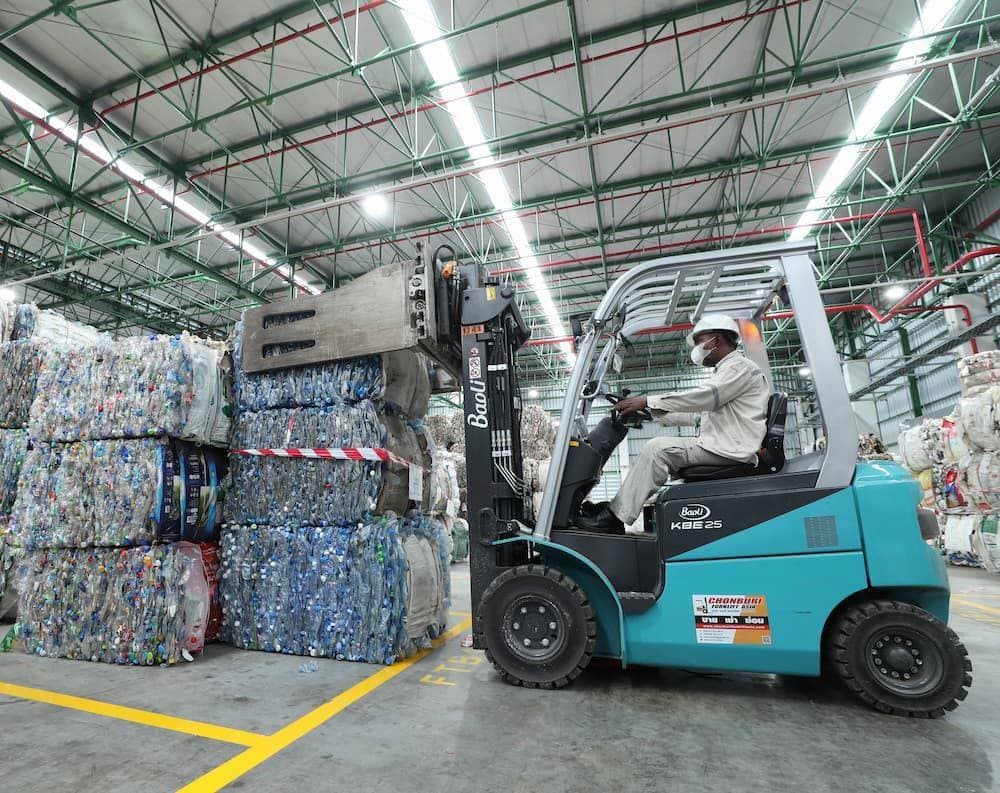
ENVICCO's carbon reduction efforts earn T-VER certification
ENVICCO, a producer of high-quality recycled plastic pellets, has joined the T-VER program by adopting sustainable production practices. The company manufactures PCR PET (rPET) and PCR HDPE (rHDPE) pellets—made entirely from post-consumer plastic bottles and packaging. In 2023, ENVICCO became the first company certified under the T-VER carbon credit standard by the TGO for its project to recover and recycle plastic waste into pellets, achieving a reduction of 18,254 tonnes of carbon dioxide equivalent.
Plastic Waste Recovery and Recycling Project by ENVICCO
ENVICCO has developed a comprehensive strategy to lower greenhouse gas emissions through plastic waste recovery, including: Developing a system to sort and recycle used plastic waste in Thailand, reducing plastic pollution Implementing an energy-efficient production process to minimize emissions in plastic manufacturing Establishing quality standards for recycled pellets that can be reused in new packaging, decreasing reliance on virgin plastics and conserving natural resources Looking ahead, ENVICCO aims to become a low-carbon business and support a circular economy. The company targets the use of over 430,000 tonnes of post-consumer plastics and plans to reduce greenhouse gas emissions by 574,700 tonnes of CO₂ equivalent by 2029.
ENVICCO: Sustainable Recycled Plastic Pellet Production
ENVICCO is a leading Manufacturer of Recycle Plastic Resin in Thailand, specializing in recycled plastic pellets such as PCR PET (rPET) for food-grade packaging and PCR HDPE (rHDPE) from post-consumer plastic bottles and containers. The company’s products lessen environmental plastic waste, conserve natural resources, and decrease emissions from new plastic production.
For more information about our products or inquiries, please fill out the contact form
Reference:
- What Is T-VER? Retrieved on 18 Feb 2025 from https://ghgreduction.tgo.or.th/th/about-tver/t-ver.html
LL8420A
Understanding Compostable Plastic: A Sustainable Alternative
The rise of compostable plastic is a significant breakthrough in the plastic industry, offering a sustainable alternative to conventional plastics. These materials help improve waste management efficiency, promote an effective circular economy, and reduce environmental impact.
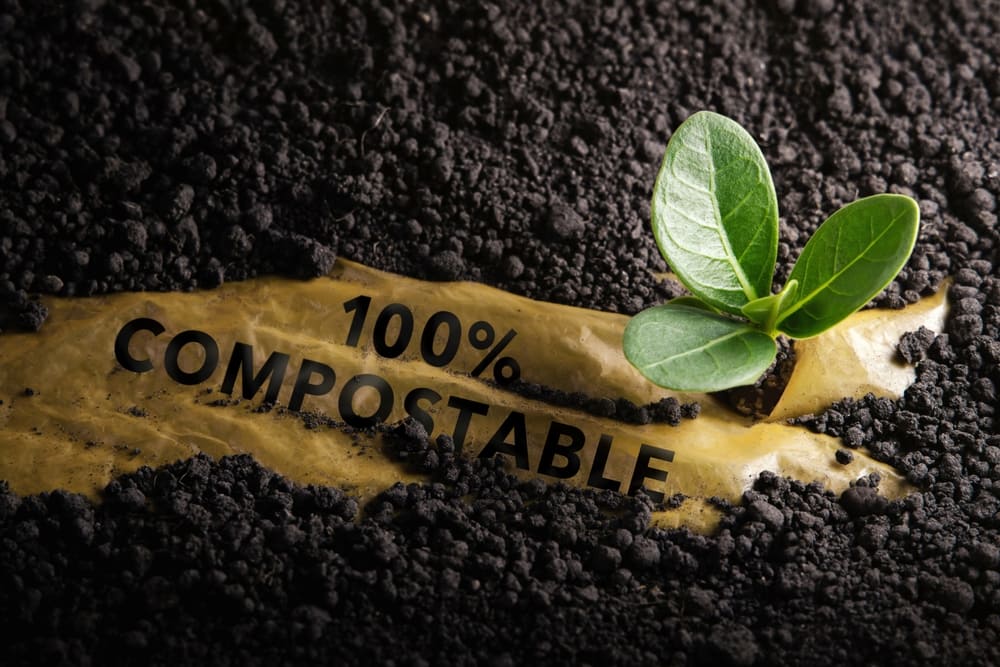
Bioplastics and Compostable Plastics: Understanding the Differences
1.1 What Are Bioplastics?
Bioplastics, with their special properties, provide more sustainable alternatives to traditional plastics. They are classified into three main groups:
1. Bioplastics made from renewable resources but not biodegradable/ Compostable
These bioplastics are produced from renewable natural materials such as cassava starch, sugarcane, and corn. Examples include Bio-PE and Bio-PET, which help reduce greenhouse gas emissions compared to petroleum-based plastics but do not naturally decompose.
2. Biodegradable bioplastics that may be derived from petroleum
Microorganisms can break down the molecular structures of some biodegradable bioplastics, such as PBAT and PCL, even though these bioplastics are sourced through fossil fuels.
3. Bioplastics that are both bio-based and biodegradable/ Compostable
The most environmentally friendly option, such as PLA, Bio PBS contributes to reducing fossil fuel dependency and persistent plastic waste accumulation.
1.2 What Is Compostable Plastic?
Compostable plastic, a type of bioplastic, is designed for complete decomposition in specific environments with the right levels of moisture, temperature, and microbial activity.Examples include PLA, PBS, PBAT, and PHA.
To be classified as compostable plastic, it must fulfill the following criteria:
- Fully decomposes under optimal composting conditions, requiring adequate moisture, temperature, and microorganisms.
- Complies with established standards such as TIS 17088, which defines testing conditions and decomposition timeframes.
- Does not leave behind microplastics or toxic residues, unlike OXO-degradable plastics, which only break into smaller fragments rather than disintegrating entirely.
- Breaks down into water, carbon dioxide, and biomass, making it safe for the environment through microbial degradation.
The Difference Between Truly Biodegradable Plastics and Misleading Claims
To help consumers make informed choices about environmentally friendly products, it’s important to recognize that marketing terms can sometimes be misleading. Many products claim to be “biodegradable”, but their actual properties and environmental impact vary significantly. One example is OXO-degradable plastics, which do not fully decompose but instead break into smaller fragments.
This following information clarifies the risks of using uncertified or deceptively marketed plastics, so consumers can choose environmentally beneficial materials.
2. The Dangers of OXO-Degradable Plastics and Microplastics
OXO-degradable plastics, while containing chemicals to speed up their breakdown, don’t completely biodegrade. Instead, they fragment into smaller pieces, ultimately becoming microplastics that remain in the environment without fully decomposing.
Impact of Microplastics
- Environmental contamination: Microplastics’ small size and resistance to conventional filtering techniques pose a significant challenge for waste management.
- Threats to marine life: Aquatic animals often ingest microplastics, mistaking them for food.
- Health risks: Microplastic exposure has been shown to disrupt respiratory, digestive, and reproductive systems across various species.
- Entry into the human food chain: Concerns about long-term health are rising due to microplastics entering the human food chain through contamination of seafood, drinking water, and the air.
3. How Are Bioplastics Composted? Decomposition Mechanisms and Standards
Biodegradation is a natural process where microorganisms break down organic materials into carbon dioxide, water, and humus.
Factors Affecting the Rate of Biodegradation
For effective bioplastic decomposition via composting, particular environmental factors are required. The key factors influencing the speed and efficiency of degradation include:
- Material composition: The speed at which a plastic degrades depends on its chemical structure and molecular complexity.
- Environmental conditions: Heat, moisture, and microbial activity all play a significant role in the composting process.
Important Standards for Biodegradable Plastics
Many countries set standards for compostable plastic to guarantee that they truly biodegrade within acceptable timeframes and safely.
Key standards include:
- Thailand: TIS 17088-2562 – certification for industrial composting processes.
- United States: ASTM D6400 – standard for compostable plastic in industrial composting facilities.
- Europe: EN 13432 – biodegradability certification for compostable materials.
- Australia: AS 4736 – certification for compostable and biodegradable plastics.
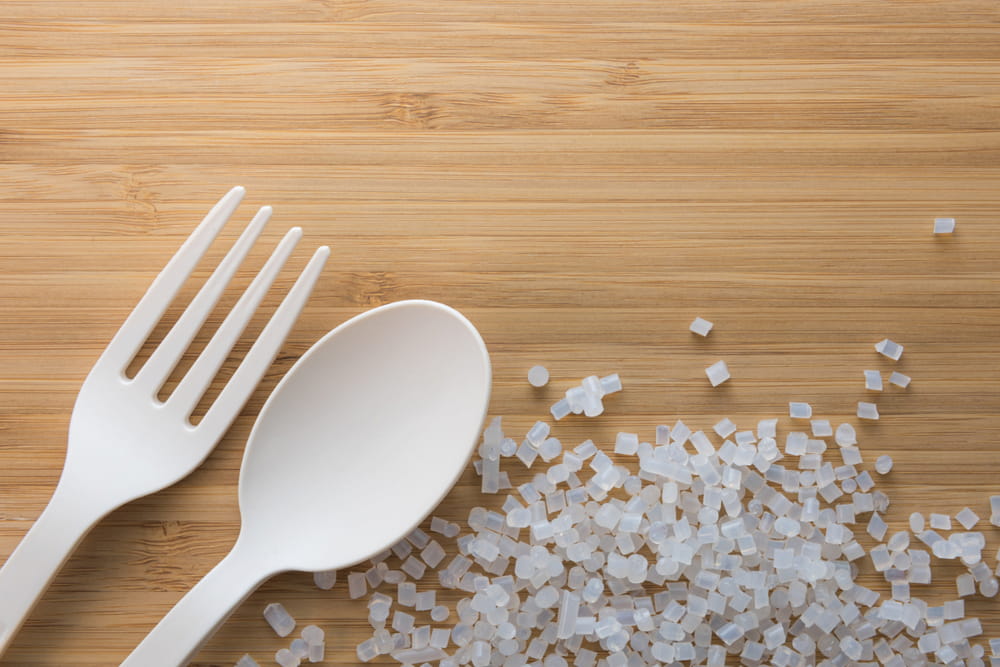
4. Choosing and Properly Disposing of Compostable Plastic
Appropriate Applications
Compostable plastic is suitable for producing:
- Single-use food packaging, includes cups, plates, cutlery, and straws.
- Organic waste bags that can decompose along with food scraps.
- Products with a high risk of environmental leakage, where compost reduces long-term pollution.
Proper Disposal Methods
To ensure compostable plastic breaks down effectively, it should be disposed of with other organic waste. The two primary composting methods include:
- Industrial Composting: Requires a temperature of at least 58°C and 90% relative humidity, taking approximately six months to fully degrade.
- Home Composting: Suitable for lower temperatures (25°C) with 50-60% humidity, typically taking around 12 months for decomposition.
Certification and Labeling
Certification and labeling help consumers identify genuine compostable plastic products, improving waste sorting and preventing greenwashing—misleading environmental claims.
Recognized certification labels include:
- DIN CERTCO (Germany): A globally recognized, strict compost standard.
- Biodegradable Products Institute (BPI) (United States): Certifies compostable products in North America.
- Thailand Bioplastics Industry Association (TBIA) (Thailand): Ensures compliance with national compost standards.
- GC Compostable Label: Indicates products or packaging made from compostable plastics developed or certified by GC Group.
5. Challenges and Sustainable Development
While compostable plastic offers innovation and benefits, widespread sustainability needs further advancements to address key challenges. This technology’s benefits are best maximized through collaboration between industries, governments, and consumers.
Current Challenges
Despite its advantages, bioplastics face several obstacles that need to be systematically addressed, including:
- Consumer confusion: Many consumers lack a clear understanding of the differences between various types of plastic, leading to incorrect disposal or misuse.
- Regulatory gaps: Clear, enforceable regulations for labeling and classifying biodegradable plastics are absent in some countries.
- Greenwashing concerns: Certain companies misrepresent their products as eco-friendly without meeting proper compost standards.
5 Key Principles for Effective and Sustainable Plastic Use
Achieving sustainability in plastic consumption requires a comprehensive and strategic approach at individual, business, and policy levels. These five principles can help guide responsible plastic usage:
- Reduce – The best way to minimize waste is by reducing unnecessary plastic consumption, especially single-use plastics. Choosing products with minimal packaging or bringing reusable containers when shopping helps cut waste at the source.
- Renewable – Supporting industries that use renewable, plant-based raw materials instead of fossil-based plastics can significantly reduce greenhouse gas emissions while boosting the agricultural sector.
- Reuse – Designing durable, long-lasting products that can be reused multiple times instead of disposable alternatives helps conserve resources and reduce
- Recycle – Developing efficient waste management systems and designing plastics that are easy to recycle (without mixing incompatible materials) ensures valuable resources are repurposed instead of ending up in landfills.
- Compostable – Using compostable plastic for products that are difficult to recycle or prone to environmental leakage, such as organic waste bags and food-contaminated packaging, helps minimize long-term pollution.
6. GC’s Innovations in Compostable Bioplastics
Eco-Friendly Bioplastic Production Technology
GC employs cutting-edge technology to develop compostable plastic, using plant-based raw materials sourced from locally grown cassava and sugarcane in Thailand. This approach supports Thai farmers, reduces dependence on fossil fuels, and helps lower greenhouse gas emissions.
Innovative Products for Various Applications
GC’s compostable plastic solutions cater to diverse applications, including food packaging (cups, plates, cutlery, and containers), organic waste bags that break down with food scraps, consumer goods packaging, and various household and industrial products.
Reducing Environmental Impact Throughout the Product Life Cycle
GC conducts Life Cycle Assessments (LCA) to evaluate the environmental footprint of its bioplastics. Research shows that GC’s compostable plastic reduces greenhouse gas emissions by more than 50% compared to conventional plastics.
The development of compostable plastic plays a vital role in addressing plastic waste issues. When combined with responsible plastic consumption and sustainable waste management practices, it significantly reduces environmental impact. To ensure genuine environmental benefit, choosing certified and standardized composting plastic products is essential.
As a leading bioplastics manufacturer in Thailand, GC is committed to producing high-quality compostable plastic to help reduce plastic waste and minimize ecological harm. If you are interested in GC’s bioplastic products or require more information, please fill out the inquiry form, and a GC representative will contact you.
References:
- พลาสติกย่อยสลายได้ทางชีวภาพ. Retrieved on March 10, 2025 from, https://www.mtec.or.th/bio-plastic/plastics-degradation/biodegradable-plastic.html
- พลาสติกย่อยสลายได้ทางชีวภาพ. Retrieved on March 10, 2025, from http://otop.dss.go.th/index.php/en/knowledge/informationrepack/394-biodegradable-plastics?showall=1&limitstart=
Event “X PURGE by GC: Enhancing Efficiency for Injection Molding” at InnoPlus Solution Center, Rayong
.jpg)
April 1, 2025, PTT Global Chemical Public Company Limited (GC) hosted “X PURGE by GC: Enhancing Efficiency for Injection Molding” event for customers from injection molding industry. The event provided an opportunity for participants to visit InnoPlus Solution Center (ISC) and observe a live demonstration of X PURGE by GC, a high-performance mechanical purging compound.
.jpg)
At this event, Ms. Netnipa Renuchart, Vice President of Emerging Platform, GC, welcomed the customers and emphasized GC’s commitment to supporting and empowering GC’s business partners with innovation and technology for sustainable growth. Following this, Mr. Kavin Choovichian, Vice President of Application Solutions, GC, introduced InnoPlus Solution Center, GC’s one-stop innovation and product development center. This center provides comprehensive support for entrepreneurs, covering all stages from concept design, material selection, formulation development, and testing to prototyping.
A key highlight of the event was the live demonstration of X PURGE by GC, a high-quality mechanical purging compound designed for efficient and rapid machine cleaning while minimizing material loss. The demonstration received great interest and positive feedback from customers. Additionally, the customers had the opportunity to engage directly with GC’s technical team and researchers, gaining in-depth knowledge of the product’s features and benefits.
GC hopes that this event will serve as a beneficial guide for our customers in enhancing their production efficiency and advancing their business operations.
HD2502C
HD2502C
HD2502C
GCM organized an event “X PURGE product refresh and demonstration the launch of X PURGE new website” for authorized trad
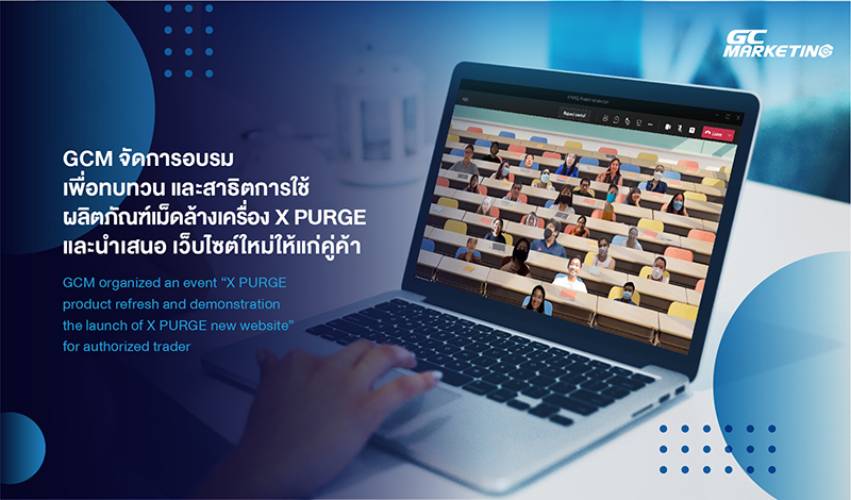 21st August 2021
21st August 2021
On 21st August 2021, GC Marketing Solutions Company Limited organized an event “X PURGE product refresh and demonstration the launch of X PURGE new website” for GCM authorized traders, including Shibaura Machine Manufacturing (Thailand) Co., Ltd., Sumitomo Corporation Thailand Co., Ltd., Hanwa Thailand Company Limited, BC Polymers Marketing Co., Ltd., Petro Polymers Co., Ltd., Petroplus Chemical Company Limited, Polymers Marketing Co., Ltd., and Liack Seng Trading Co., Ltd.. The goal of this event is to look at how X PURGE products can be used and to introduce new product grades, such as X PURGE PX319, which was developed by the Research and Development Institute to improve cleaning capabilities. Its distinctive feature is the absence of smoke and smell. Thus, it is suitable for machines manufactured in Clean Room or the manufacturing of other hygienic products.
Furthermore, the new website of X PURGE was introduced, and its application was demonstrated. It can be used to search for appropriate X PURGE products match for any specific usages. Also, it includes an analytical tool for calculating the value added from utilizing X PURGE products.
According to the event, customers got an opportunity to acquire better understandings of X PURGE products and the application of the analysis tool on its new website. It
MOU Signing Ceremony between GCM and Veechem Global Fzco for Distributorship of X PURGE Purging Compound
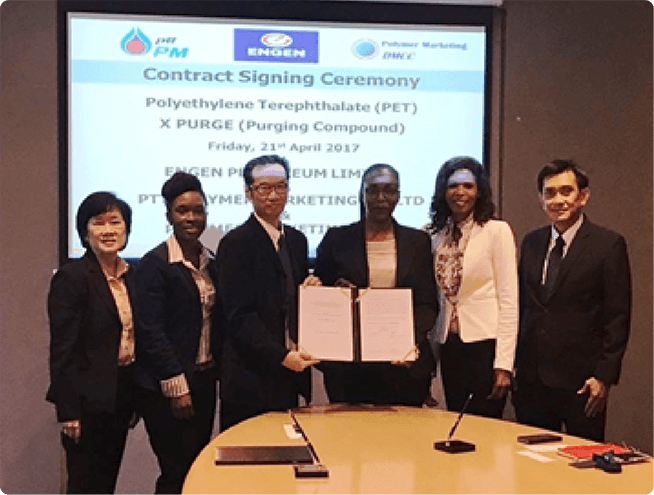
25 April,2018
Ms. Somsri Phanichrungruang, Vice President, Export Sales Department, Mr.Paiboon Prapussornchaikul, Vice President, Specialty Products Department, Mr. Watcharasit Reinsriwong, Vice President, Technical Support Department of GCM and Mr. Pravesh V. Jethwani, CEO of Veechem Global Fzco Ltd., attended the Signing Ceremony of a Memorandum of Understanding between GCM and Veechem Global Fzco for distributorship of X PURGE purging compound of GCM in United Arab Emirates and Ethiopia.
The signing of this MOU will add new synergies and values for both Veechem Global Fzco and GCM in the years ahead. The signing ceremony took place in Sheraton addis ababa, Addis Ababa, Ethiopia on 25 April 2017.


